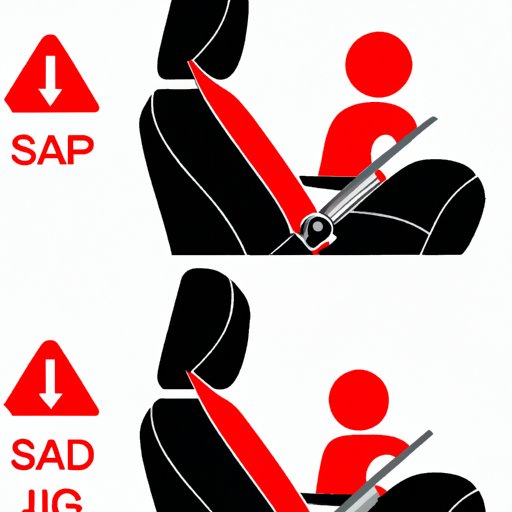
Introduction
Car seat safety is crucial to the protection of children while driving. According to the Centers for Disease Control and Prevention, car accidents are a leading cause of death for children in the US. Therefore, it’s important for parents and caregivers to understand the importance of properly installing and using a car seat. In this article, we’ll cover when you can turn a car seat forward-facing and the steps to do so safely.
The Ultimate Guide to Turning Your Child’s Car Seat Forward: A Step-by-Step Process
Before turning a child’s car seat forward-facing, it’s important to know how to do it correctly. Here is a step-by-step guide:
- Step 1: Read the car seat manual and the vehicle owner’s manual before beginning.
- Step 2: Make sure your child meets the age, weight, and height requirements for forward-facing seats.
- Step 3: Ensure the car seat is installed correctly in the vehicle’s back seat.
- Step 4: Adjust the harness straps to sit at or above your child’s shoulders.
- Step 5: Adjust the angle of the car seat so it’s leaning back slightly.
- Step 6: Turn the car seat forward-facing and lock it securely in place.
- Step 7: Adjust the harness straps again and tighten them so they fit snugly against your child’s body.
When Can You Turn Your Car Seat Forward Facing? Everything You Need to Know
The decision on when to turn a child’s car seat from rear-facing to forward-facing depends on various factors:
- Age and weight limits: The American Academy of Pediatrics recommends children remain rear-facing until they reach two years of age or until they exceed the weight and height limit of the car seat. Check the car seat manual to determine the specific limits for your model.
- Height limitations: When your child’s head is less than an inch from the top of the car seat, it’s time to turn the seat forward-facing.
- Other safety factors to consider: Some car seats have specific guidelines for turning them forward-facing. Always consult the manufacturer’s instructions before making the switch.
- Common misconceptions: Parents often presume that once their child has reached a certain age, they can turn the car seat around forward-facing. However, children need to meet the height and weight requirements specified for their car seat model.
The Importance of Keeping Your Child Rear-Facing in a Car Seat and When It’s Safe to Turn Them Around
The American Academy of Pediatrics recommends keeping children rear-facing for as long as possible. Rear-facing car seats provide more protection for a child’s head, neck, and spine during a crash. Children should remain rear-facing until they reach the weight and height limits of the car seat. Every car seat has different limits, so it’s essential to read your particular model’s instructions.
When your child has outgrown their rear-facing car seat, it’s time to turn them around. Doing so too soon can result in injuries, especially if they’re involved in a car crash. Once turned forward-facing, make sure the harness is adjusted correctly to fit your child’s body, and they sit in the car seat with their back firmly against the seat and their neck supported by the headrest.
The Top Factors to Consider Before Turning Your Child’s Car Seat Forward
Before making the decision to turn your child’s car seat forward-facing, there are several factors to keep in mind:
- Safety considerations: Always follow the manufacturer’s instructions and ensure you understand the safety requirements before turning the car seat forward-facing.
- Comfort and convenience considerations: Make sure the car seat is adjusted correctly to your child’s body and that they are comfortable while in it. Check that your child can bend their knees and rest their feet comfortably on the floor of the car.
- Cost and longevity of the car seat: Children grow and change. Invest in a car seat that can accommodate your child’s growth and development, so you don’t have to buy a new one frequently.
- Car compatibility: Not all car seats are compatible with all vehicles. Make sure the car seat you are purchasing fits your car correctly and that you understand how to install it safely.
Breaking Down Car Seat Laws and Regulations: A Quick Guide to When You Can Turn Your Child’s Car Seat Forward
Laws on when you can turn a child’s car seat around forward-facing vary depending on the state. Here’s what you need to know:
- Height requirements: Some states have specific height requirements rather than weight limits for turning car seats forward-facing.
- Age and weight requirements: Many states have laws that require children to remain rear-facing until two years of age or until they surpass the stated weight limit for their car seat.
- Exceptions: Some states allow parents to turn their child’s car seat forward-facing earlier than this if their child has a specific condition or disability.
Conclusion
Turning a child’s car seat from rear-facing to forward-facing is a significant decision for any parent. It’s essential to keep safety in mind and understand the various rules and regulations surrounding car seat use. By following the manufacturer’s instructions and considering your child’s age, weight, and height, you’ll ensure that your child travels safely in the car.
If you’re unsure about when to turn your child’s car seat forward-facing or have any questions about car seat safety, consult with a professional or your pediatrician. Always prioritize the safety of your child while driving on the road.





